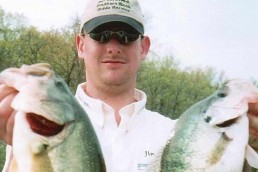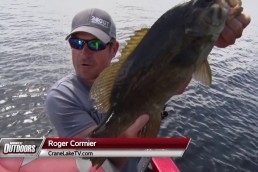Spoonbill Season in Full Swing at Lake of the Ozarks
SHARE THIS POST
By now, some of Missouri’s hardiest anglers have geared up for an unusual form of fishing—they are snaggers, bent on harvesting a few goliaths that inhabit our rivers and reservoirs. Their quarry is the elusive, prehistoric spoonbill or paddlefish. These fish were thought to be alive in the Pleistocene Epoch, and how they survived when thousands of other plants and animals became extinct remains a mystery.
Not related to catfish in any way, this filter feeder is one of the oldest surviving species on the continent. It’s amazing that any freshwater life form could grow to such proportions by eating zooplankton and insect larvae. More incredible is the fact that they feed by swimming with their mouths wide open. The Missouri state-record fish weighed 140 pounds, 9 ounces, and was caught by Andy Belobraydic III in March 2015 on Table Rock Lake.
The cartilage forms the skeleton of a spoonbill, the same way as it does for a shark; there are no bones. Even their smooth, tough skin resembles a shark in color and texture. Aside from the sport of trying to land a very large fish, many would argue their steaks and filets are among the very best freshwater table fare.
In the spring, spoonbills migrate from their lake or river habitat upstream to spawn. However, when Truman Dam was built at the headwaters of Lake of the Ozarks, their route to spawning areas was blocked. The Missouri Department of Conservation (MDC) anticipated this problem and developed methods to hatch and grow spoonbills. Each year the MDC stocks thousands of them in Table Rock, Truman, and Lake of the Ozarks. Without this intervention, spoonbills would disappear from these lakes.
Angling for this fish in the 40- to 100-pound range that only feeds only on microscopic aquatic life poses some interesting challenges. Because of their food source, it takes a unique method called “snagging” to catch them, and is only allowed for about six weeks in the spring on most waters. The tackle consists of a rod with the flex of a telephone pole, spooled with 80- to 100-pound-test line with a large treble hook and weight attached. Not just any weight mind you; to reach the spoonbill’s depth it requires a 12- to 16-ounce lead weight.
The idea is to troll very slowly in a likely area, letting out enough line for the hook and weight to run the same depth as fish marked on a depth finder. The angler makes continuous, slow, sweeping hook-set motions with the rod, hoping to snag this fish with the treble hook.
Are you enjoying this post?
You can be among the first to get the latest info on where to go, what to use and how to use it!
This sport is not for wimps, as it is hard work and will definitely strain your triceps, biceps, deltoids and trapezius muscles. When you snag a spoonbill it is not like hooking a catfish in the mouth where the angler has some control. Mostly, they are hooked in the belly, across the back or in the tail section, giving them the leverage.
Most anglers troll too fast, causing the hooks to ride above the depths where the fish are holding. Even with 12 to 16 ounces of weight, the larger diameter of 100-pound-test line and lead weight displaces so much water that the hook rides too shallow.
The trick is to troll with a small kicker motor or use the bow-mounted trolling motor, where possible, and use braided line because of the small diameter and because it lets the hooks run deeper. (Triggered by water flow and temperature, smaller males usually precede the larger females.)
Some popular Lake of the Ozarks snagging areas are just below the Route 65 Bridge near Warsaw, around the 55-mile mark of the Osage, from the junction of the Big and Little Niangua Arms to the Clearwater Condominiums, the Glaize Arm and in the Osage River below the Route 54 Bridge. No-snagging zones extend from Bagnell Dam to the Route 54 Bridge of the Osage River, and from Truman Dam to the Route 65 Bridge in the lake’s Osage Arm.
The legal length limit was raised from 24 to 34 inches (eye to fork-of-the-tail) a few years ago in Lake of the Ozarks, Truman and Table Rock lakes and their tributaries. In all other waters, paddlefish less than 24 inches must be returned to the water unharmed immediately. The daily limit is two, and the possession limit is four. It is illegal to buy, sell, offer to sell, or use any spoonbill parts or eggs for bait.
For regulations on the Mississippi River, see huntfish.mdc.mo.gov/fishing/species/paddlefish/paddlefish-seasons-hours. Until the season ends, get some heavy tackle, liniment for your sore muscles, and try these big bruisers.
MWO
SHARE THIS POST
Did you enjoy this post?
You can be among the first to get the latest info on where to go, what to use and how to use it!
Darrell Taylor
Darrell Taylor has fished for more than 65 years. During the past 25 years, Taylor has generated more than 2,000 published articles, columns and fishing reports. His writings received 14 peer-level awards from outdoor writer organizations, including the Association of Great Lakes Outdoor Writers “Excellence in Craft” Golden Glow Award, their highest recognition.



